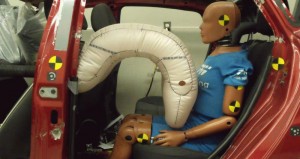
TRW Automotive Holdings Corp. (NYSE: TRW) is outlining at Airbag 2014 how a combination of advanced restraint systems can help to address the protection of rear seat occupants during frontal impacts.
TRW is today outlining at Airbag 2014 how a combination of advanced restraint systems can help to address the protection of rear seat occupants during frontal impacts. Airbags that address features distinctive to the rear seat environment, when implemented with advanced seat belt systems, can help to reduce injury to rear seat occupants.
Dirk Schultz, director of Inflatable Restraints for TRW Occupant Safety Systems, said: “We conducted an analysis of the German In-Depth Accident Study database for information on injury patterns of rear-seated occupants from 1999 to 2013. Findings indicated that half of all injuries to rear seat occupants are caused by head impact to the front seat, or high seat belt loading to the thorax.
“During frontal impacts, the protection of rear seat occupants differs from those of occupants in front seats. Protecting rear seat occupants can be a challenge, considering the larger range of occupant ages and sizes – from child to adult – and vehicle interior space that varies depending on the position of the front seat.
“Advanced restraint systems such as seat belts, pretensioners and load limiters can help to reduce the injury potential on the rear sear occupant.”
Airbags that address features distinctive to the rear seat environment, when implemented with advanced seat belt systems, can help to reduce injury to rear seat occupants. TRW is highlighting a number of advanced rear seat technologies in its exhibit, including:
Roof-mounted rear airbag concept
Features unique to the rear seat compartment include a wider range of occupant ages, sizes and positions of front seats. After numerous occupant simulations, as well as static and dynamic testing using 5th, 50th and 95th percentile dummies, TRW has adapted its front seat ‘bag-in-roof’ concept to the rear seat environment. A roof-mounted rear airbag concept – when used in combination with a seat belt equipped with a retractor pretensioner and single constant load limiter – helps to reduce the likelihood of rear seat occupant head contact with the front seat, even in small vehicle compartments and when the front seat is positioned further back into the rear seat space.
Front-seat mounted rear airbag concept
An advanced rear airbag design placed on the rear-facing side of front seats is positioned to help protect rear seat occupants. Front seats that adjust in a longitudinal direction can lead to varying distances between the back of the seat and rear occupants. However, the unique shape of TRW’s advanced rear airbag concept adjusts to the different distances between the rear seat occupant and the front seat. The rear seat airbag concept provides coverage when the front seat is in a very forward position, and helps to avoid high loading of the occupant when the front seat is positioned further back into the rear seat space. (see accompanying image).
TRW anticipates that both its roof mounted rear airbag and front seat mounted rear airbag will be ready for production in late 2017.

